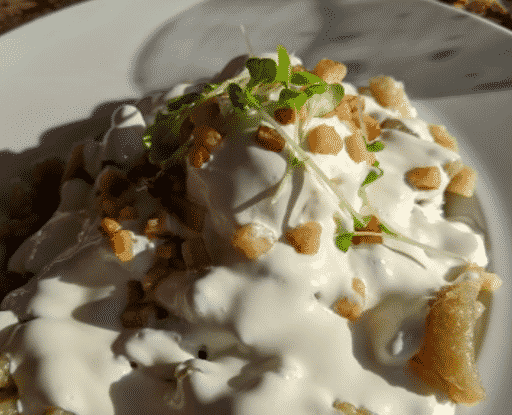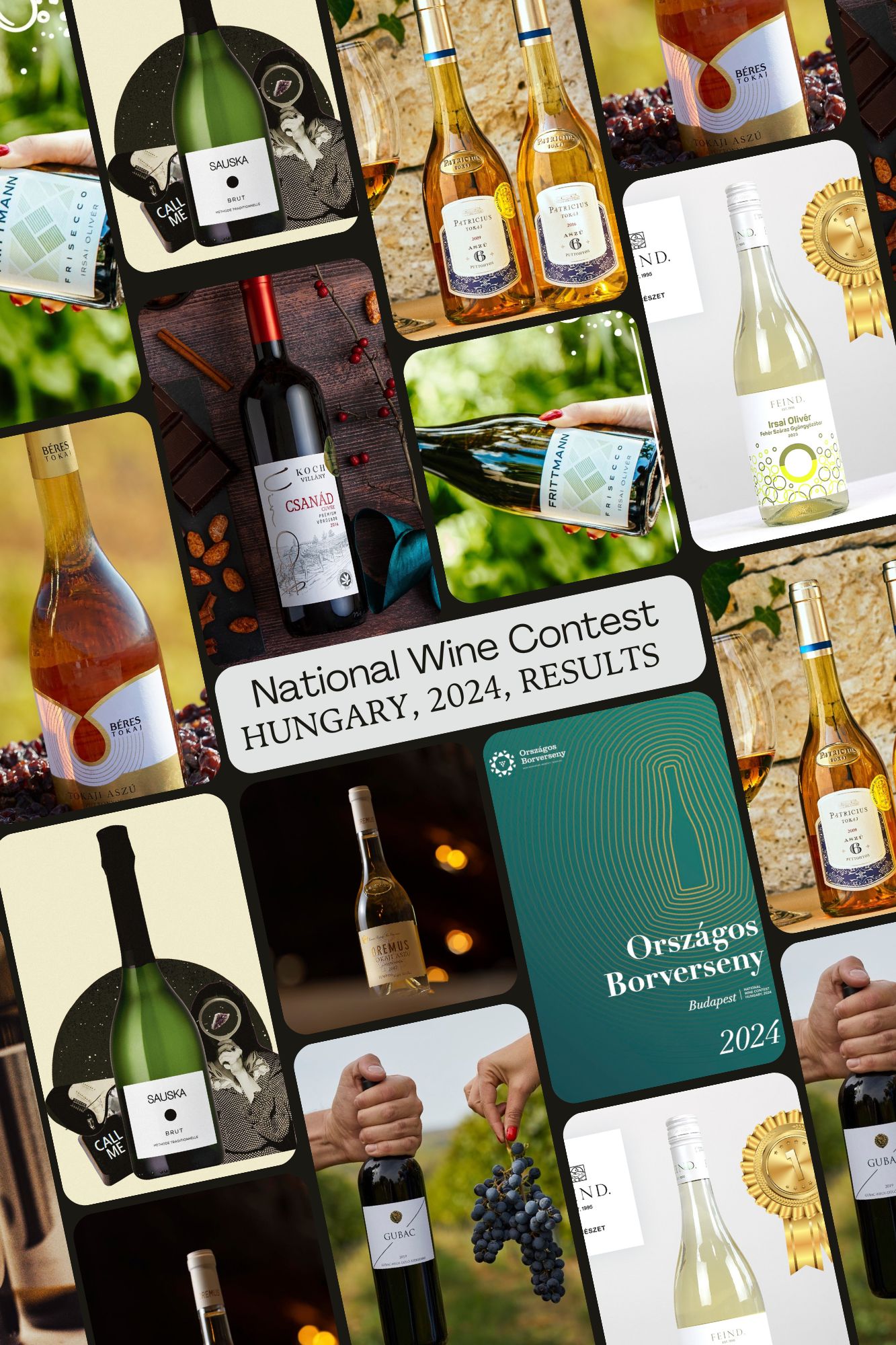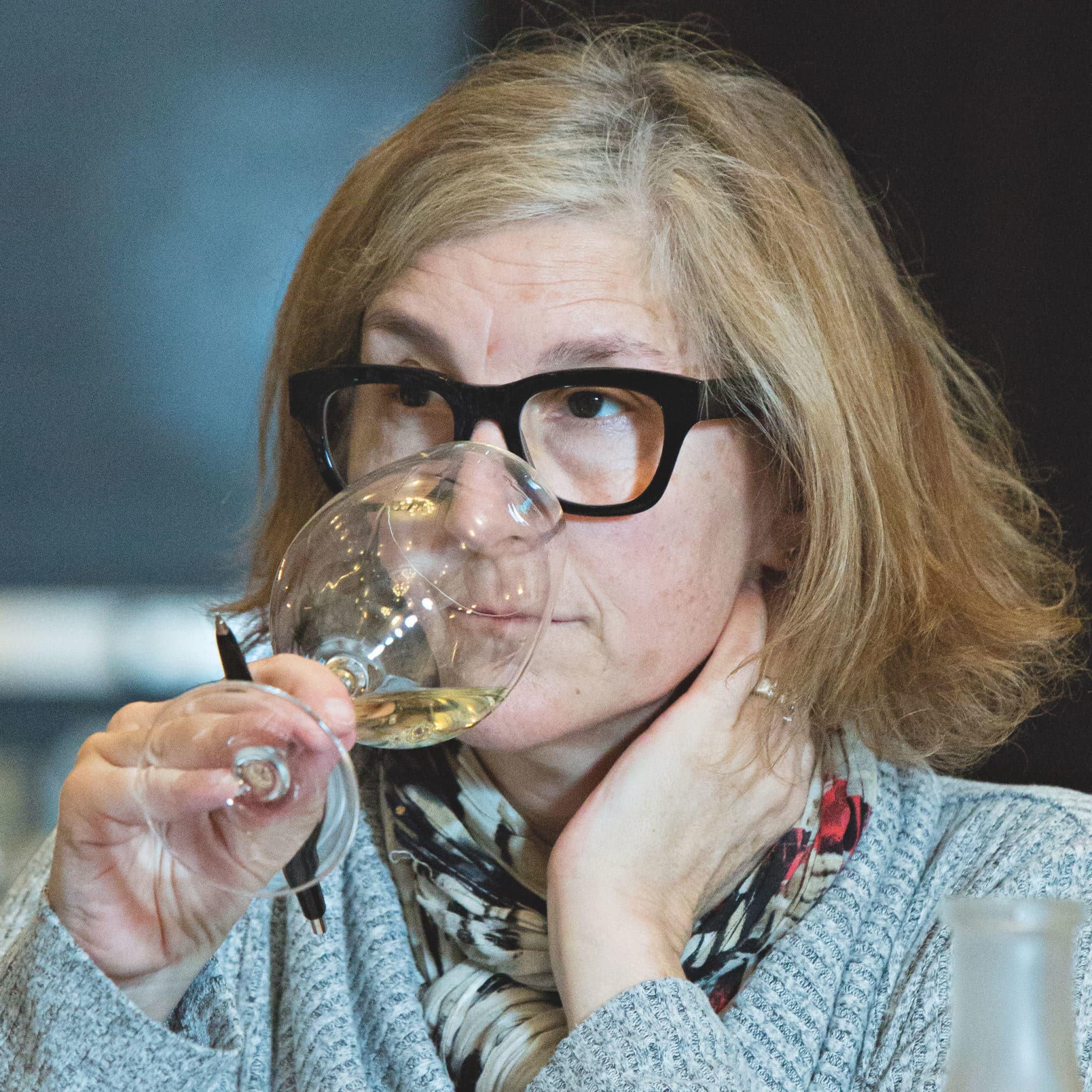
Good Wine Gal’s First Wine Adventure to Hungary!
The following article is written by Barb Wild, the Good Wine Gal.
This is a story about me, Good Wine Gal, a Canadian wine lover traveling to Hungary for the first time ever. I landed Budapest in February of 2020 to spend time in the birthplace of my grandfather (born in 1902) and to taste Hungarian wine in hopes of connecting not only to my family roots but also to good Hungarian wine.
Prologue
I was born a Hungarian Princess. It was not a secret but it had no confirmation. As the story goes, there was a glorious castle in Hungary bearing our family name. In my imagination one day I would claim my crown and my home. Hungary after all was a land of green rolling hills, large stone castles, horse drawn carriages, rose gardens, fancy ball gowns and feasts of fanciful roasts, handmade sausages, drop egg noodle dumplings, beautiful multi-layer cakes and fruit strudels accompanied by fountains of flowing champagne. Who wouldn’t want to live in Hungary?
Introduction
It was February 2020. I had not intended to be travelling again so soon after visiting France, but here I was arriving in the iconic and delicious Budapest at the beginning of what would become the global pandemic. My invitation to explore Hungarian wine for the first time in my wine life was underway. I had longed to travel in the steps of my ancestors to uncover the truth of my heritage. I was prepared – fancy dress and all.
The New & Old Grapes & Wines of Hungary
Olaszrizling
Olaszrizling is the Hungarian name for Welschriesling. It is also known by its Croatian name as Grasvina. Where does the “Welsch” come from? According to Oz Clarke, the most likely possibility is Walachia (think wine region Walachian Hills in Romania). Laski Rizling is its name in Slovenia and in all cases, not similar to German Riesling except that it is a white grape producing white wine. While this grape can produce quality wine, its reputation ebbs to the lower end of the quality scale historically. Olaszrizling is very versatile wine with neutral, nutty flavours and aromas, medium acidity with mid body weight and ample roundness. Controlling yields and a good wine maker can take this grape variety from so so to sensational as we discovered in the tasting. The simpler styles are pleasant enough and perfect for an everyday, lunch, dinner even patio party and beach babe wine (don’t forget to add a few cubes of ice).
Olaszrizling was possibly the first Hungarian word I leaned. To be a judge for a panel tasting of 36 styles of wine was a dream come true for a new apprentice wine judge like me. This professional tasting began in with introductions in Hungarian (of which I speak none) followed by kind translations and welcoming smiles. At about the 20th wine – each similar in appearance and subtlety as the previous 19 – “palate fatigue” was setting in. To stay fresh, sipping water and managing a bite of cracker was the only way. The wines came quickly in flights of four and the tasting was over in a short two hours with very little discussion, written words and mathematical calculations. There were some gems discovered and celebrated after the tasting ended. I salute my favorite wine of the tasting with a photo.
Villány – Csányi Winery
After the tasting, we hopped into an SUV and in the darkness, raced south along the highway to Villány arriving in the dead of night. I suspect that we woke up the neighbours and their dogs by closing the vehicle doors in unison and dragging our cases across the paved lot. In a welcoming gesture of the wine kind, a bottle of sparkling was opened and we toasted to the success of the day and our new friendships.
Teleki Tradicio 1881 Brut Rosé is made in true Champagne traditional method. With fine petulance and fresh stone and citrus fruit notes, it offers excellent acidity and freshness with a nice soft elegant palate and lingering finish.
It also was the perfect hello and good night. Sleep came instantly as head met pillow. I salute this bottle with a photo.
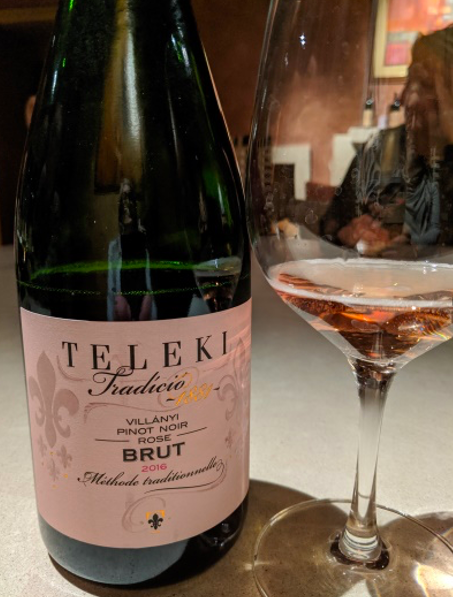
Villányi Franc
Csanyi Winery (pinceszet) in Villány is a large working winery operation complete with miles of underground caves, a beautiful, well-lit underground tasting room and several guest rooms.
We toured the winery and its 100 year old underground caves. The path we followed made sense only to the moving of oak barrels and fermented juice (and perhaps hiding refugees back in the day). We ended up naturally in this beautiful underground tasting room set with five styles of wine for our tasting led by one of Hungary’s leading winemakers.
Cabernet Franc is not Hungarian. Its origin lies in the Bordeaux region of France. “Always the bridesmaid never the bride” is the saying – and it’s true in Bordeaux for Cab Franc. The origins of Cab Franc in this region are likely connected to the spread of Phylloxera which devastated vineyards in France during the mid-1850s. As the vignerons fled to other parts of Europe hoping to save their vines and escape the vine louse, Bordeaux varieties reached far and wide. Here the Cabernet Franc magic springs from the climate and soils of Villain. It is a marriage of unmistakable chemistry – both spiritual and physical. It is aromatically pretty, red and black fruit driven wine that has a nice body with ample freshness with versions influenced by time in Hungarian Oak or French Oak barrels or none of the above. I salute one of my favorite tastes with the picture.
2015 Teleki Tradicio 1881 Villanyi Franc. After a couple of years in fine oak it brings big flavour, mouthfilling richness with enough acidity and balance to the palate with lingering flavours of wild black and red berries and wonderful spices – a harmonious showcase of what Cab Franc can be!
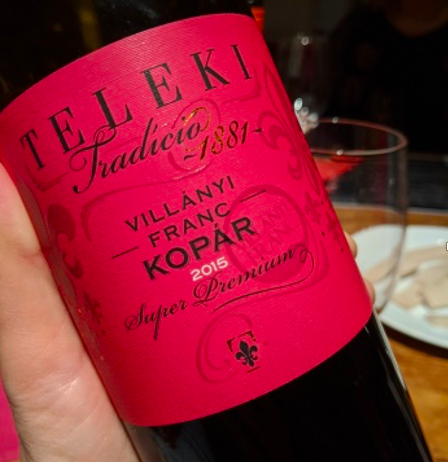
Villány – A. Gere Winery
The town of Villány on our grey February morning was dreary. Spirits lifted as we walked into the village. The town was filled with tasting rooms reminding my travelling companions of Beaune, France. The streetscape of wineries, restaurants and shops were ready and waiting to welcome travellers of the wine kind.
A trip to Villány would not be complete visit without a stop at A.Gere Winery. Here we tasted a red indigenous grape variety – the name of which I cannot pronounce, that has been resurrected with care and is showing great promise and unique distinction. Is it going to be the new cult wine favorite in Hungary? I salute this fine bottle and it’s early morning influence that left a bit of a spell on me.
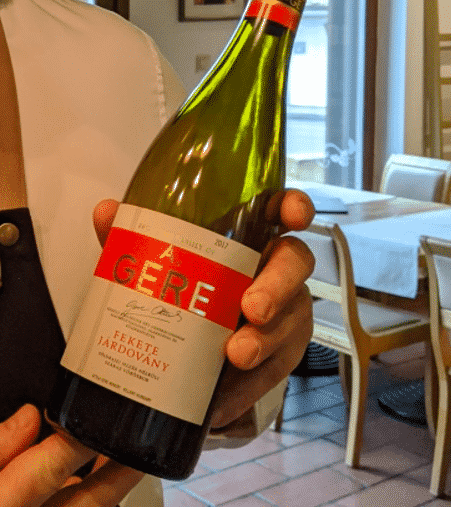
The Slow Train
Our meandering turned into a mad dash for the last train to Budapest. We arrived on time with a few fancy chocolate bars to nosh and a bottle in our bag, as the train slowly pulled into the station. The arrival signaled by the ringing of a bell, somewhat grand however there were only two cars attached. Up we dragged our bags, giggling from our consumption and the oddity of this relic of a train. Seats are upright and immoveable. The laughter continued. This 50s feeling was not the first and probably not the last but oh, the irony of it all. How modern the wine, how not modern the train but both were needed to get us back to Budapest. And then we realized – no cork screw.
As our luck continued, there was one stop before a long continued 3 hour journey to Budapest. It was at this stop that our bold and daring wine sister leapt off the train, dashed into the office at the station, convinced a total stranger to give up his wine opener and then dove back onto the car, just in time to wave goodbye to the station master. The stories and laughter didn’t wind down until the train slowed for its arrival in Budapest. Now it was time for our second wind as we hopped into a waiting car and headed east towards Tokaj.
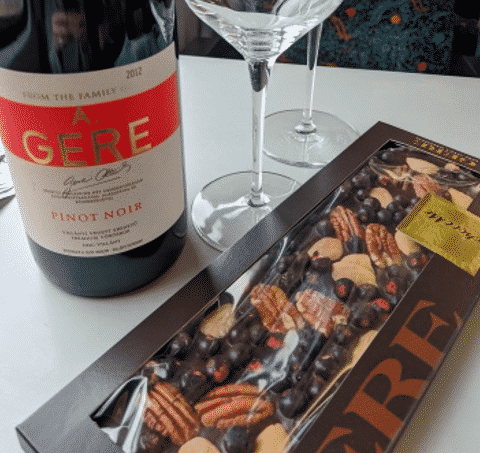
Tokaj – Préselő
Tokaji needs no introduction. It is one of the most famous wines in the world. It satisfied the hunger for sweetness then and now. It’s perfect balance of refreshing acidity and intoxicating nectar of honeyed dried apricots is divine and unmistakeable. Its rise to fame, like other sweet wines of the time provided an uncommon sensual taste experience in an era where sugar was not yet traded.
Furmint & Hárslevelű
The demand for sweet wine is in decline and the interest in dry wine is on the rise. The grapes however, like my heritage, remain constant. The grapes are unmistakably indigenous and almost unpronounceable with Furmint and Hárslevelű being the most widely planted.
Furmint is indigenous to Tokaj. This is Croatia’s Posip and Romania’s Grasa and a parent of Hárslevelű Furmint has high acidity, finesse, structure and the ability to age. It can go from dry, steely, lime peel and pears to sweet dried apricots, almonds and honey and with age it becomes very complex and exotic. Where the beauty of sweet tokaji brings all the complexity, dry Furmint is less so posing challenges for marketers and maybe confusing for consumers.
Hárslevelű is the second grape of Tokaj. In a dry style (which seems less common) it offers delicate aromas and flavours of green pear, elderflower and garden herbs. In sweet wines it brings intensity and complexity with roundness, making it the perfect partner to Furmint for Tokaji.
Once again, the arrival was in the dark of night. We were welcomed to Préselő Winery by our handsome host. After a fabulous home cooked meal, we tasted nine styles of dry (Szamorodni), medium sweet (Aszú) and sweet (5 & 6 puttonyos) Tokaji. It was first and only time I lost control. Falling into bed that night the happy grin was not only for the journey, or the thought of my grandfather who would have been proud of me, but also for the divine pleasure of sipping Tokaji in Tokaj – splendid as well as unforgettable. I salute Préselő with a picture of the bottles we tasted.

Tokaj – Patricius
The next morning, after a delicate breakfast and coffee, all roads led to Patricius Winery. Here the main tasting room and winery below, sit up on a knoll that gives panoramic 180 degree perspective to the surrounding, ancient, lands with boundaries and landmarks that have remained unchanged for hundreds of years. I felt it in my bones. The spiritual awakening continued as we walked in the vine rows, toured the winery and barrel room.
We tasted, spat, wrote, and held a handful of dried aszú berries – eating several – completing the deep connection of Tokaji – body, mind and spirit. The award winning personalities and wines made the experience of tasting completely memorable. I salute Patricius with a photo of the bottles we tasted.
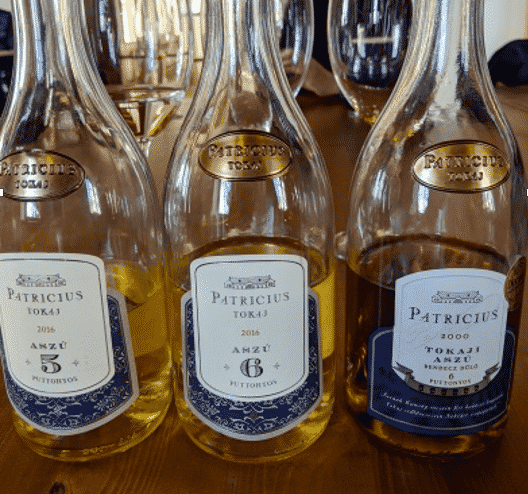
Eger
We headed back to Budapest via Eger. Eger is an ancient and famous city where one of the most ferocious battles was fought against the Ottomans and a turning point for the Hungarians in history. Here Bull’s Blood, famous for its contribution to the great battle (this is the wine they warriors consumed), is the wine of choice.
Kékfrankos is the main grape variety of Bull’s Blood (in Hungarian called Egri Bikavér). This is a flavourful red wine with edges in youth and structure to the end. Tannins can grip and flavours are a mix of red and black fruit with notes of herbs, spice and mineral. In other lands,like Austria’s Burgenland (which lies just across the border from Hungary), it is called Blaufränkisch and in Germany, Blauer Lemberger.
After a short tour and delicious lunch of more traditional Hungarian cuisine like my grandmonther would make, it was time to return to Budapest. After a meaningful farewell to new friends, it was time to journey on. It felt like I was the Hungarian princess I have always been, even if just on the inside. As for the wine – the adventure of Hungarian wine had just begun.
